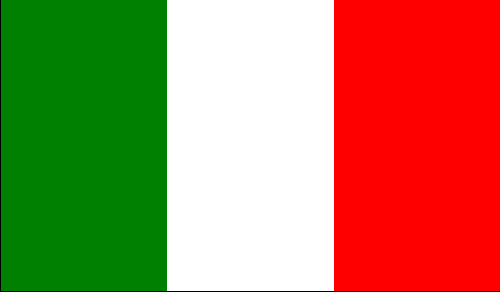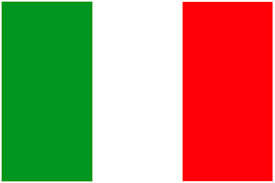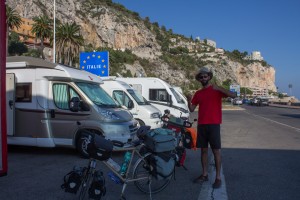Italy

We arrive in the land of pizzas children! It is very hot here, even in September. It feels like people are singing instead of talking, and very loud!
Saturday September 27, 2014, we cross the French-Italian border. We leave the country by sea on October 13.
Where is Italy?
Its flag:
General data :
- Population : 60 770 000 habitants.
- Capital : Rome.
- Official language : Italian.
- Diet : parliamentary democracy.
- Surface : 302,000 km² with 2 independent landlocked states, the Vatican and San Marino.
- Cash : the Euro (€)
- Jet lag : none.
- A few seats wholebres (listed as UNESCO World Heritage):
– In Veneto: The city of Verona
– In Tuscany: the historic center of Florence (listed in 1982); historic center of Siena (1990); Piazza del Duomo in Pisa (1997): three cities we visited!
– In Campania: the historic center of Naples; the archaeological areas of Pompeii, Herculaneum and Torre Annunziata.
– In Puglia: Castel del Monte
What we noticed, we…
– We find fountains very easily, on squares or in children's play gardens. No need to use the water filter in Italy!
- There are sorting bins everywhere, in all towns and villages. You always have to think about which trash can to use: paper, glass, plastic, etc. They each have their own color.
- There is a lot of scooters or motorbikes everywhere; and if the Italians don't always speak English very well, they don't hesitate to show us where to go by taking us on a scooter.
– Some prices : Coffee: €1.50 – 1L of gasoline: from €1.60 to €1.80!
- THE basic words who served us every day: “Ciao” (hello, or also goodbye) – “grazie mille” (thank you very much) – “per favore” (please)
- Overall, it's still a country close to France!
Geography
Italy is in Europe and the European Union. So at the border, it was very simple: no passport to show or paper to make. It looked like a highway toll and there were just a few policemen watching.
Come on, little geo reminders ...
Italy is easily recognized on the map of Europe by its boot shape. It also has two islands in its territory: Sardinia and Sicily.
The country has common borders with: France, Switzerland, Austria, Slovenia and Croatia. It is attached to the European continent with the Alps. The Italian Boot plunges deep into the Mediterranean. This stretch from west to east makes Italy an intermediary country between Europe and the Middle East, on the one hand, and Europe and Africa, on the other.
Weather
You can travel to Northern Italy (where you go) almost all year round. On site, two types of climate:
- Weather continental inside the ground, with temperatures higher than ours in summer, but lower also in winter;
- Mediterranean climate on the coast.
Cuisine
The cuisine is very regional, even more so than in France: each region has its recipes and specialties. Some examples of traditional Italian dishes:
Pizza : It was born in Naples and was the staple food for dockworkers. There are nearly 200 varieties of preparations. Even if the kingdom of pizza is further south of La Botte, the northern regions do not turn their backs on it. Restaurants normally only turn on their wood-fired oven for evening pizza.
Pasta (Pasta) : Dry pasta, fresh pasta: the border between southern and northern Italy is located there. The North is renowned in the manufacture of fresh egg pasta made from soft wheat flour, and the South in the manufacture of dry pasta made from durum wheat semolina.
Risotto : Traditionally cooked in Piedmont, Lombardy, Emilia-Romagna, Veneto and Friuli, risotto occupies a special place. The risotto is based on Italian rice, i.e. round rice, which originates from the Orient. At the origin of all risotto, there is a broth that is traditionally prepared the day before. It can be made from meat, offal, fish or vegetables. The best known is the saffron risotto (prepared with saffron).
Desserts (Desserts) : Italians don't eat a lot of sweets at the end of a meal. They prefer them made at home, or eat them in the afternoon. We find the Grandmother's cake, the homemade cake, often very good; or even the typical tiramisu, cake made with mascarpone (heavy cream) and cookies soaked in coffee and marsala, all sprinkled with cocoa. And especially when we talk about desserts, we can not forget the ice cream (ice creams), if deemed; or the smoothie, fruit puree elongated with milk or crushed ice.
Culture
- Painting, sculpture and architecture
Since ancient times, Italy has been one of the great hotbeds of Western art and architecture. Italian art has its origins in the Greek and Etruscan cultures. The influence of the Roman Catholic Church on the whole of Italian artistic production is considerable.
The Quattrocento (Renaissance) Italy is famous in the arts for its production during the Renaissance (The Renaissance: a period of great cultural changes in Europe, in the 15th and 16th centuries). Depth of field, perspective, naturalistic view of the world ... Italian painters upset the rules of the art in the 15th century. The city of Florence was at its peak during this period. Many artists became famous there: Botticelli, Leonardo da Vinci or Michelangelo.
- Cinema
Italian cinema was also famous, and this was especially after the Second World War. Italian films from this period are known all over the world: films from the neo-realism, filmed with non-professional actors, which show the reality of Italy at the time. The two great masters of this movement are Roberto Rossellini (paisa, Rome open city) and Vittorio de Sica (The Bicycle Thief).
From the 1950s to the 1970s, Italian 7th Art experienced its golden age, with filmmakers with styles and universes as different as Luchino Visconti (Cheetah, Death in Venice), Federico Fellini (La Strada, Amarcord) and Michelangelo Antonioni (The adventure, The night). It’s also the heyday of Italian comedy with awesome actors like Alberto Sordi, Sophia Loren, Marcello Mastroianni or Claudia Cardinale.
Source : http://www.routard.com/guide/italie/654/carte_d_identite.htm Thank you backpacker!


